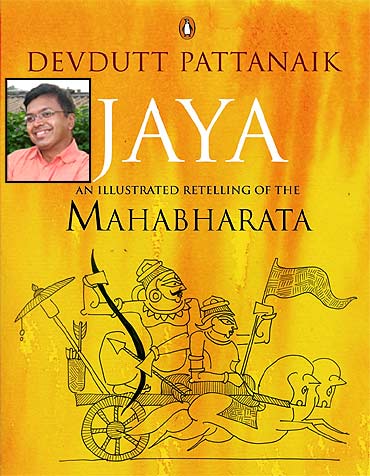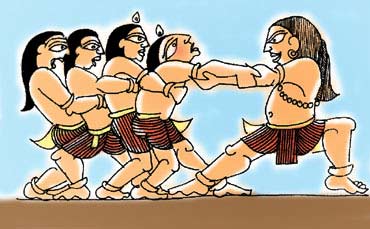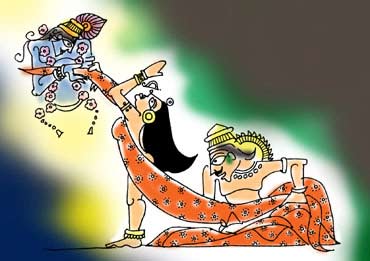
Pattanaik, a self-taught mythologist, also lectures extensively on the relevance of sacred stories, symbols and rituals in modern times, especially in the corporate world. Besides the Future group, he also consults many organisations such as Star TV and the World Gold Council on issues related to storytelling, leadership and culture.
He has published over 15 books, including 7 Secrets of Hindu Calendar Art (Westland) and Myth=Mithya (Penguin) and now, Jaya: An illustrated retelling of the Mahabharata. What makes Devdutt unique is the accessibility and applicability of his decoding that reaches out to the common man.
In an email interview, the Mumbai-based Devdutt Pattanaik spoke to rediff.com about his latest book on the Mahabharata and the lessons the epic holds for today's times.
Yet another version of the Mahabharata! Why would anyone want to recast Vyasa's grand epic? That too in a grossly condensed form?There are not many versions that are accessible to the public, as we are led to believe.
The last time I went to the book shop there was C Rajagopalachari, Ramesh Menon, Kamala Subramanium, William Buck, Amar Chitra Katha comics and then fiction works based on the Mahabharata such as Palace of Illusions and the Great Indian Novel.
My book gives the illusion of being condensed. It has more stories, more images, and more information than any other version. There are tales from folk and regional variants and I have related the stories to cultural impact, ritual practices and various interpretations, both rationalist and mythic.
The trick is to capture the soul of the epic and not waste time with unnecessary descriptions and dialogues. Very few people I know are aware of the depth of the epic and the patterns therein. We overestimate our knowledge of Mahabharata. It is extremely poor.
Most Indians own a copy of the Mahabharata. Who will want to read yet another one, albeit an abridged Mahabharata, you think?Not really. Most Indians do not read. Even B R Chopra's great television serial ends in the 12th chapter, at the end of the war There are six chapters after this and the only thing we know about it is what Amar Chitra Katha chose to tell us.
No one has told us how Bhima ill-treated Dhritarashtra after the war. No one told us of the snake sacrifice where the epic was first narrated. No one told us the stories of Budh and Ila and Yayati's daughter Madhavi or the stories of Aravan or Barbareek.
Image: The cover of Jaya: An illustrated retelling of the Mahabharata. (inset) Devdutt Pattanaik

The fact that everyone assumed they knew the Mahabharata. And most storytellers had presented it without actually understanding it so the underlying theme seems rather pedestrian. That there is a vast repository of tales that is inaccessible to most people simply because it is not presented in an accessible form.
Condensing the world's longest epic cannot have been easy. What have you left out from the original, and what criterion did you employ to decide what's to be left out?I have left out long boring descriptions and dialogues. I have left out repetitions and depth and unrelated side stories. Except the original translations, no retelling tells the 'whole' Mahabharata. Most storytellers have left out the sexual details, the queer tales, the dark violence, the tales that challenge the righteousness of heroes.
How long did the process of writing Jaya take, from conception to execution?Three years to prepare the manuscript and one year for production.
What, in your opinion, is the best takeaway from the Mahabharata for today's time and age?The Mahabharata's lessons are eternal. It does not change with time. It simply says that you are not what you have. When you derive your perception of yourself from possessions, you are doomed.
Tell us some facts that most of us Indians are ignorant about the Mahabharata?1. There are 18 chapters that speak of an 18-day war with 18 armies in which God sang a song with 18 sections.
2. In the book, the Pandavas are told to kill their father (Bhishma, who raised them as a foster father), their teacher (Drona), their brother (Karna), their uncle (Shalya).
3. Kauravas die and the Pandavas lose all their children: so what was the victory celebrations about?
4. Draupadi rejected Karna on account of his caste
5. Kunti did not want Madri to have more children than her
6. Gandhari refused to remove her blindfold to see her children
7. Bhima had a son called Barbareek
8. Arjuna had a son called Aravan
How relevant is the idea of dharma, the foundation of Yudhishtra and most of the epic, in today's world? How many Indians even think of dharma in their day-to-day lives?We assume the meaning of dharma is righteousness or goodness or justice. Because righteousness, goodness and justice depend on a measuring scale. Depending on who is measuring and who has creating the measuring scale our notions of righteousness, goodness and justice changes.
We assume that dharma is about rule-keeping and so are bewildered why the dharma-keeping Krishna is breaking the rules. As I said, most storytellers retell the story without actually studying the idea of dharma. So what emerges is a pedestrian understanding of dharma.
Dharma is about outgrowing the animal desire to be territorial and dominating. Animals are territorial and dominating in order to survive. Humans are territorial and dominating in order to protect their perceived self-images. That is adharma. Even the idea that we can own pieces of the earth is a human delusion that fuels adharma. Dharma is about discovering our humanity, outgrowing our need for property and recognising the role property plays in our life.

The assumption in your question is the one who asks for land is Pandavas and those who do not give are Kauravas. So from a Pakistani writer's point of view, India is Kauravas. From an Indian writer's point of view, Pakistan is Kauravas.
The idea of property is a human construction, made by humans, for humans, without considering the fact that animals and plants have a right to the land too. In order to secure human rights, we violate animal and plant rights. This is cultural delusion. So the very notion of property is adharma. To fight over it as dogs over bones is also adharma.
The Pandavas think their kingdom is property and gamble it away. That is adharma. Kauravas feel their kingdom is property that must not be shared. That is also adharma. The war is not about teaching the Kauravas a lesson; it is to teach even the Pandavas a lesson so that they govern the earth with dharma in their soul. Till the last chapter, the Pandavas struggle with the notion of dharma.
India and Pakistan -- shades of cousins fighting it out till death in the epic?Who are the Pandavas here? Mahabharata is Dharma-yuddha or war for establishment of dharma, and dharma is not about property and power and politics.
Do you see a loose parallel between Karna and Arjun and Varun and Rahul Gandhi? Heirs to the same royal family but one of them born at the wrong time.Not really. Both are fighting for personal ambitions and wealth. No one is thinking about the nation. If they thought of the nation, they would include each other. Karna did not think of the world at large but focussed only on his loyalty and friendship. And Arjuna did not think of the world at large and was only consumed by the guilt he would accrue by fighting his elders and teachers. Dharma is about thinking about others and not self-aggrandisement.
Similarly, between Sonia and Dr Singh and the epic's Krishna and Arjun?Such parallels are superficial. They focus on the cosmetics of the epic and not the soul.
What war did the Pandavas actually win? They lost all their children. Imagine if you won a lottery and on that day you are told all your children are dead, would you happy?
This is my problem with earlier retellings of the Mahabharata. Simple data points are ignored and so bizarre interpretations emerge.
I mean. in B R Chopra's Mahabharata, the Pandavas and Draupadi are so happy on the coronation day. Your children are dead, crazy people! The lesson is far more spectacular and transcendental. It is not about winning. It is about dharma. The two are not the same.
Your website says you try to motivate 'people leverage the power of myths/subjective truth in business, management and life'. But business in a competitive world often endorses unethical stances, which is bereft of values (Bhopal, Enron). How does your inspirational perception tackle these 'unholy' trends?Every time a farm is built, a forest is burned. Ask the birds whose nest was destroyed, if the farmer is holy.
Every time we wear gold ornaments, let us remind ourselves that the gold comes from mining and mining destroys many ecosystems.
The marble on the floor of our house and in our toilets came after mountains were destroyed. Are we holy?
The bull is castrated for the bullock cart. The calf is yanked away so that we can drink cow's milk.
Before we judge corporate houses, let us judge ourselves. Human civilisation is based on the violent domestication of nature. So these 'unholy trends' are part of human civilisation. We just are not aware of it.
We encourage our children to be competitive in schools. This is the sanskar we give them. Why do we get upset when it carries forward into the corporate world?
Recently, in Mumbai, a man died on a railway overbridge. For nine hours no one moved the body, not the police, not the railways, not the passengers. Are we even aware of these unholy trends within the average middle class man?
We are looking for media scapegoats like corporations, when the dark side is not out there, but in our hearts. It is everywhere.
Every moment is the war at Kurukshetra. We just do not realise it because we are too busy being smug that we are the Pandavas.
Everywhere we find Kauravas who assume they are Pandavas. So it is very relevant within and even outside the Future group.
Is it practical to follow the Gita's message of karm kiye jaa, phal ki icchcha mat rakh today? Or have we moved to a stage where maybe the Machiavellian strategies in Mahabharata make more sense?Are you asking for sanction to follow 'unholy' trends? (Laughs) We have the freedom to do what ever we wish. That is the human prerogative. In the end, who loses but us when we choose to ignore the words of God? Let us not claim helplessness simply because we live in 'modern times'.
Why do we Indians love the Mahabharata so, despite its unusual storyline of a woman married to five men, a transvestite killing a grandfatherly figure and almost all the protagonists dying a rather painful death in the last act?We like the epic because they show the dark side of human character. It recognises that no human being is perfect. It recognises the struggle of humanity to be good. Such honesty is rare amongst Indians, who otherwise enjoy denial.
The painful death you refer to in the last act is actually in the 17th chapter. There is an 18th chapter that uplifts the book to another plane and justifies why the original title of the book was Jaya.
The Mahabharata portrays a time of liberated social mores -- when pre-marital sex, extra-marital sex etc abounded. Today, in contrast, we seem so much in thrall of the moral police. How and when did we regress so?I don't think this is regression or that was progress. We have to understand the context of 'liberated' sexual behaviour. Each is a function of thought. When there was no concept of property, there was no concept of inheritance, and hence no one cared for paternity, hence it was not necessary to demand marital fidelity of a woman. All things changed when the notion of property emerged.
What does the Mahabharata tell us about ourselves?That we are still animals, fighting for survival. Only we fight for our imagined self-image. We have not evolved.
What forgotten lessons from the Mahabharata are we condemned to repeat, you think?We forget to empathise, be generous, and share. We exclude people. This will invariably lead to violence. We cannot escape it.